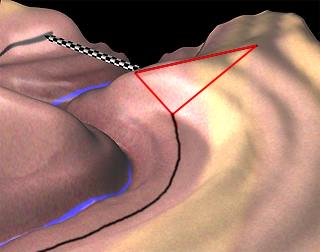

In this contour map we see a river valley with a road (black line) coming in from the west (assume north is up), and it cross the river via bridge (chain like stucture on map) and then heads north.
Someone has decided to continue the road south, and is trying to do it without building another bridge or digging a tunnel (both very expensive). The proposed route is shown by the red line. Since the original road is already between 200 and 250 feet on the contour map, we might as well keep it relatively flat and cut through the hill.
If we tried to cut the road around the hill we would find a steep gradient between the road and the river below. So it was deemed best to put it through the hill by creating a false canyon.
So our next step is to look at the maximum gradient of a road running through the hill. We do an elevation map based on the ridge line.
Assuming we make the road straight, then we can place it on the elevation map at about 200 ft. and then look at the needed slopes to make a safe cut through the hill. The cut to the east will need to remove far more material to achieve a good gradient.
We can determine the acceptable angle by knowing the geology of the hill, and what the regolith can handle safely.
We will probably need to remove material back to the 500 ft. elevation and maybe the 550 ft. elevation to get a safe gradient. The third picture shows an estimate of what will need to be removed to create a safe gradient for the road sides.
The last image now shows the new contour map as it would be drawn after the cut was made through the hill. There is now a small hill to the west of the road and a fairly gradual cut on the eastern flank back to the 550 ft mark.

| NEXT | TOC | PREV |